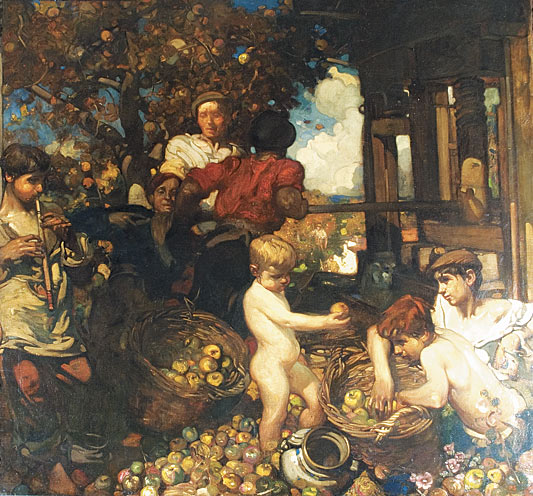
Cider Press 1902
Framed (ref: 3151)
78 x 78 in. (198 x 198 cm).
Tags: Frank Brangwyn oil allegory children farms/domestic animals men women work

78 x 78 in. (198 x 198 cm).
Tags: Frank Brangwyn oil allegory children farms/domestic animals men women work
Provenance: Sir Alfred East RA ; Captain Winterbottom
Exhibited: New Gallery, 1902 (lent by East?); Venice Biennale,
1903; Venice Biennale, 1914; Queen's Gate, 1924 Catalogue: 58 (lent by
H W [sic] Winterbottom, titled Cyder Press); St Louis International
Exhibition, St Louis, 1904 Catalogue: 43
Literature: Shaw-Sparrow, Frank Brangwyn and his Work, Kegan Paul, Trench, Trubner & Co Ltd London 1915 p231
H Furst, The Decorative Art of Frank Brangwyn, The Bodley Head London 1924 p214
Art Journal, p85-86 March 1903, F Rinder, 'The Art of Frank Brangwyn'
The Studio, p38 Vol 26, June 1902, 'Some Paintings and Sculpture at the London Spring Exhibitions'
P Macer-Wright, Brangwyn, A Study of Genius at Close Quarters, Hutchinson & Co London p67
Illustrated: Shaw-Sparrow, The Spirit of the Age, London, 1905 plate 8
Amelia Defries, Frank Brangwyn RA, Master Craftsman, American Magazine of Art November 1924 11 Vol. 15p562
The Studio, p37 Vol 26, June 1902, 'Some Paintings and Sculpture at the London Spring Exhibitions'
St Louis International Exhibition, St Louis 1904 p63
The British Art Journal, p41 Libby Horner, 'Brangwyn and the Horton House mystery'
Notes: Described as a ‘lyrical fantasy from the conditions of
modern life’* portraying ‘the half-triumphant, half-sad sentiment of
October’.* The oil shows two young boys and a nude toddler right
foreground, lounging over baskets of gleaming apples and a beautiful
pot, whilst to the left a man plays a flute, and others work at the
press, the frame of which can be seen background right. The red shirt
of the central figure provides a focus point. Although the painting is
quite dark in tone there is a wonderful sense of light flickering
through the central window of sky. There is something of the Old
Masters in this painting, although the technique is vastly different,
and a romantic yearning for the glories of rural England. Marion
Spielman described this painting as ‘one of (Brangwyn’s) most opulent
designs, such as Titian might rejoice in could he come to life in the
twentieth century’,* and The Studio critic, less ostentatiously, called
it 'masterly in handling and sumptuous in colour'.* Laurence Bradshaw
noted in his copy of the Queen's Gate catalogue that the technique was
'earlier' and 'tighter' and commented on the unfortunate habit of
owners of varnishing paintings with the result that they ended up brown
and cracked when all they required was a little soap and water to
remove dust and dirt. Rinder termed the oil a 'robust idealisation of
an incident charged with beauty and with significance' and considered
it a 'noteworthy attempt to express the half-triumphant, half-sad
sentiment of October'. The RA sketchbooks have drawings of a cider
press at Weford on Avon which may be related to this painting. In 1904
(17 January) Brangwyn wrote to Kitson that he was 'very sorry that the
Cider Press is not going to Leeds, East wished it to go to St Louis,
anyway next year you shall have it', and on 9 November 1907 he noted
that, with East's approval, it was to be sent to the Salon in 1908.
According to Macer-Wright, East purchased the work for £300 to help the
younger artist out of financial difficulties, but the claim cannot be
substantiated. There is no concrete evidence that after the early years
Brangwyn was troubled by impecuniosity. From 1891 to 1894 he was able
to afford two studios, he employed an assistant as early as 1895, and
by 1902 was established and greatly in demand. Brangwyn borrowed the
painting from East to send to an exhibition in Munich, but apparently
the packing case was destroyed when on the docks at Tilbury. East
recovered the canvas and had it relined and restored. It was sold later
for £1400. In 1924 Furst recalled 'the beautiful early rich and mellow
Cider-press which alone would secure to its author a place amongst the
great masters'*, gracing the walls of Horton House (Colonel
Winterbottom's residence). In a letter to de Belleroche, 8 April 1952,
Brangwyn asks if he has been able to trace 'Sir Roberts of Saltair who
had the Cider Press he was the partner of Sir Titus Salt who made the
Town of Saltair in Yorkshire'. Some of his other suggestions of
ownership in the letter were decidedly wrong so this comment may be
misleading! * Shaw Sparrow, p231 * F Rinder, p82 * The Studio, p38 *
Furst, p214